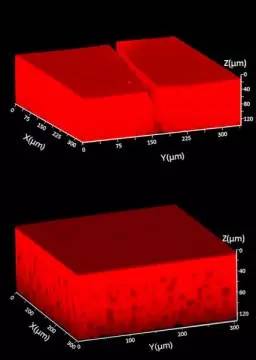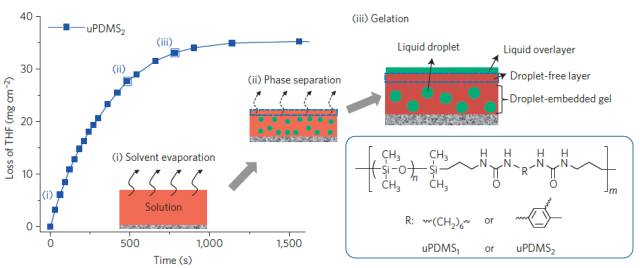以往,我们对流体释放量的调控依赖于带有隔离装置的设备。这不仅难以连续性精确调节释放量,而且也很难适用于监管和功能性整合方面。来自美国哈佛大学的Joanna Aizenberg研究组由生物组织自身调节功能想到将储液隔室掺杂于超分子聚合物(脲-PDMS共聚物)凝胶基材中,并保持材料外表面具有一层薄薄的液膜。隔室、基材和表面层的动态流体交换使得材料表面能够反复地起到自润滑作用,同时也达到基材本身修复功能。当表面流体有耗散,或局部材料损坏时,聚合物交联,液滴收缩和流体交换体系会通过动态反馈将储存液体释放出来。并且该动态反馈可通过体系光学透明性的变化数显出来。

储液隔室掺杂于超分子聚合物(脲-PDMS共聚物)凝胶修复性能;三维共聚焦荧光图:上图为破坏后半小时的照片;下图为修复72小时后的照片

该制备体系需具备以下特征:第一,聚合物与储存液滴之间要有化学亲和力,且其成键强度既要足以稳定液滴,又不能影响键重组和诱导释放,如超分子聚合物;第二,要有包覆液滴的动力学形成机制,如相分离。
其设计理念主要是基于以下条件:液滴-凝胶界面与其内部能量损失有关,EA=nAγgl,其中n、A和γgl分别表示液滴的数目、表面积和界面能。因此从热力学角度考虑,这对液滴降低其表面积是有利的,但是相关聚合物键重组时候会产生动力学能阻,如果基材交联成键的能量足以稳定住液滴,即Ebond10kBT,其中kB表示玻尔兹曼常数,T为凝胶温度,体系将会处于亚稳态。与此同时,只要铺展系数S= γga - (γla + γgl)>0,其中γga、γla、γgl分别为凝胶-空气,液滴-空气,凝胶-液滴之间的界面张力,凝胶外部表面将会涂覆一层稳定的液膜,且该液膜厚度取决于分离压力,尤其是数十至数百纳米范围内。若该膜层遭到破坏,分离压力将会产生一种驱动力进行修复,使其达到初始厚度。虽然初始分离压力源于凝胶表面的范德华作用力,但是流体连贯性使得压力也能够作用于基材内部液滴。若Ebond 低于10kBT,该分离压力也足以使储存液滴得到释放,且键重组会抑制任何由于液滴收缩引起的机械应力聚积。液滴尺寸的降低将会减弱材料本体的光散射,由于储液量的减少,凝胶会变得更加透明,因而方便读数。
制备方法大致如下:先将uPDMS共聚物,硅油和THF均相溶液在玻璃表面涂层,THF挥发使其在液-气界面凝胶化,形成无液滴涂层。随着溶剂进一步挥发,uPDMS在膜内部交联,发生相分离:微米级油滴在溶液本体内开始成核,并通过相互融合不断长大,以降低能量损失EA。最终在膜本体内发生凝胶化,稳定油滴并阻止其进一步融合。液滴最终尺寸大小与分布取决于相分离的动力学和凝胶化过程。

Figure 2 Characterization of thedroplet-embedded gel structure. THFevaporation from a solution of uPDMS2polymer, silicone oil and THF, and corresponding schematic of theself-formation of the droplet-embedded gel film: (i) homogeneous solution; (ii)phase separation; (iii) isolated liquid droplets trapped within the hydrogen-bondedcrosslinked gel
摘要速递:
Dynamic polymer systems with self-regulated secretion for the control of surface properties and material healing
Nature Materials
doi:10.1038/nmat4325
online 22 June 2015
Approaches for regulated fluid secretion, which typically rely on fluid encapsulation and release from a shelled compartment, do not usually allow a fine continuous modulation of secretion, and can be difficult to adapt for monitoring or function-integration purposes1, 2, 3, 4, 5. Here, we report self-regulated, self-reporting secretion systems consisting of liquid-storage compartments in a supramolecular polymer-gel matrix with a thin liquid layer on top, and demonstrate that dynamic liquid exchange between the compartments, matrix and surface layer allows repeated, responsive self-lubrication of the surface and cooperative healing of the matrix. Depletion of the surface liquid or local material damage induces secretion of the stored liquid via a dynamic feedback between polymer crosslinking, droplet shrinkage and liquid transport that can be read out through changes in the system’s optical transparency. We foresee diverse applications in fluid delivery, wetting and adhesion control, and material self-repair
————引自“高分子科学前沿”



